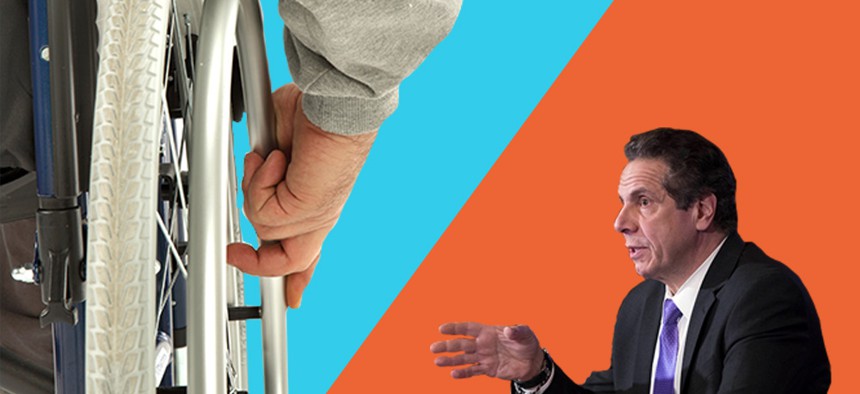More people could end up institutionalized because of state budget
The final budget ignored desperate cries to increase affordable and accessible housing, boost funding for independent living services, and ensure our personal attendants are paid a fair wage.

Gov. Andrew Cuomo and a person in a wheelchair Photos by Office of the Governor and Shutterstock; Illustration by Zach Williams/ NYN Media
I am someone who happens to have a disability, and I work to ensure other New Yorkers with disabilities are able to live independently and in the community. Sadly, this year’s final budget was disastrous for us.
The final budget ignored desperate cries to increase affordable and accessible housing, boost funding for independent living services, and ensure our personal attendants are paid a fair wage. This was came on top of changes to Medicaid that will both encourage institutionalization and cost the New York state more money in the future.
Several years ago, the state transitioned its Medicaid program from fee-for-service, sometimes called “straight” Medicaid, into a managed care system with managed long-term care (MLTC) for those who qualify. MLTC provides long-term supports and services to people with chronic disabilities. To promote independence and community living, supports and services should ideally be home- and community- based, but could nevertheless be provided in an institution, like a nursing facility.
Before transitioning services provided in nursing facilities to managed care, the state noted that “nursing home costs (being) ‘carved out’ of managed care rates ... had the potential to encourage managed care plans to pressure high-cost people served in community-based settings to enter nursing homes.” In other words, putting nursing facilities into managed care would help make sure people were not forced into an institution. But in this year’s budget, the state incentivizes institutionalization by undoing this transition.
To fully grasp the meaning of this, consider whether you would want to live in your own home, direct your own personal attendants, and participate in the community – or live in an institution, segregated from society without control over when you wake, sleep, eat, or bathe. More troubling than even the state not taking its own advice is that providing services in the most integrated setting possible (i.e. the community) is required by the U.S. Supreme Court in the Olmstead decision.
Furthermore, by doing this the state is also choosing to increase its costs. Except in cases of especially high-needs individuals, home and community-based services (HCBS) are less expensive than institutional care. The nonpartisan National Council on Disability has reported that it costs New York on average $337,625 annually per person to provide services in an institution, but only $69,752 annually to serve someone in the community.
All New Yorkers, especially those with disabilities, should be deeply troubled by the state’s willingness to encourage institutionalization against the social good, and against its financial interest. While it’s too late to change the state budget, we need to keep in mind moving forward how decisions in Albany are hurting disabled people across the state.
NEXT STORY: It's time to meet millennials where they give
